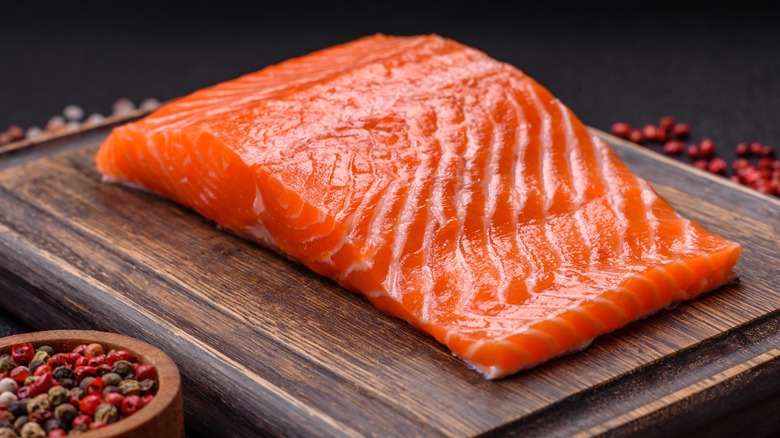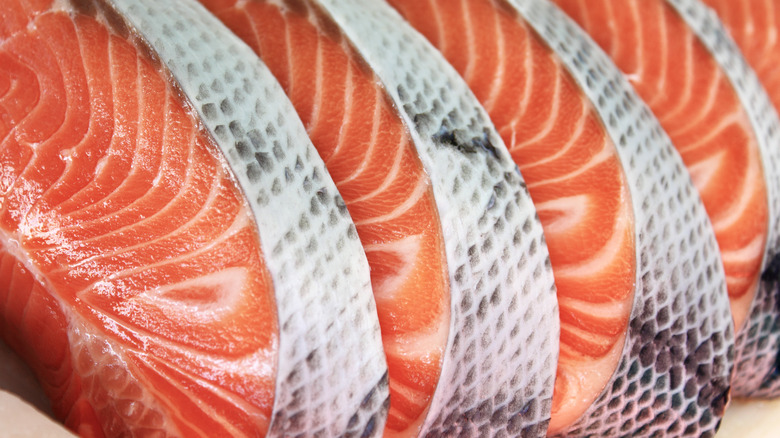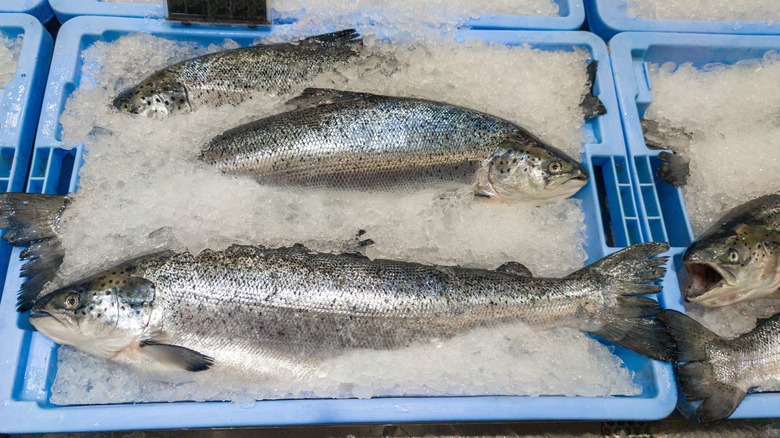How Much Salmon Should You Usually Serve Per Person?
If you have a dinner party in the works or you're trying to squeeze more omega-3 fatty acids into your diet, salmon is always a solid choice. It has lots of lean protein, is available fresh or frozen in most grocery stores, and is just as good poached with a mustard dill sauce as it is simply grilled in the summer with a fresh salad. However, salmon isn't cheap and it has a short shelf life, so it's important to make sure you're only buying as much as you're going to eat in one or two meals. Each person will eat about 6 to 8 ounces of salmon, so multiply that by the number of people coming to dinner and you'll always have enough fish for everyone.
If that sounds too easy, you're not entirely wrong because there's a catch. Salmon can be sold in various forms depending on how much the fish has been butchered. So while the actual amount of fish eaten is always the same per person no matter how you buy the fish, you'll need to tack on a little extra weight to account for extra parts like bones and skin.
Salmon filets versus steaks
The portion size of salmon is about the same as most other proteins, but the difference is that most of us don't regularly buy as much of it as, say, chicken breast or beef. With most other meats at the grocery store, there isn't usually a lot of choice in how they're sold: Beef comes as steaks or roasts, chicken comes in pieces, and so on. Fish, on the other hand, can be sold with the skin on or off, bones intact, with or without scales, and even whole with the head still attached. The closer you get to a whole fish without butchering, the better the price will be. However, bones and skin will increase the weight you need to buy.
Probably the most common forms of salmon you'll find at the grocery store are filets (both with and without skin), and salmon steaks (which have a small amount of bone in the center). Regardless, filets and steaks don't have a ton of skin and bones, so the weight won't be hugely affected, and you can still stick to buying about 6 to 8 ounces per person. If you plan to remove the skin and bones at home, lean more toward 8 ounces per person so there's some wiggle room for loss.
Whole and half salmon
If you're throwing a party for more than 10 people, it's time to think seriously about buying a bulk piece of fish or a whole salmon that can be portioned at home. Not only will it save you money, but you'll also be able to get a better idea of how fresh the fish is by looking at the eyes, fins, and gills. Most whole salmon sold at grocery stores and fish markets weigh around 10 pounds, and half a fish (or "a side") is about 5 pounds. If you're doing the math, a whole fish should work out to around 26 portions for a whole fish, but that's not factoring in the weight of the head, skin, tail, and bones. If you're buying a whole fish, a good chunk of weight will be cut away, so estimate a portion size of around 12 to 16 ounces per person, which means a whole 10-pound fish will actually serve around 10 to 12 people.
If you're only buying a side of salmon with skin, there will be less loss. It's always better to have a little extra than not enough food, so plan for 8 to 12 ounces per person to account for losing the skin. That means a 5-pound side of salmon will serve around six to seven people. If you end up with a little extra, don't sweat it — there are lots of ways to use up leftover salmon.


